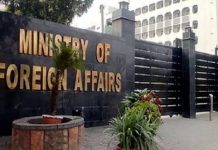Nestled along the southwestern coastline of Pakistan, Gwadar emerges as a beacon of potential and promise in the realm of global trade and economic development. Situated at the crossroads of major maritime routes and strategically positioned at the entrance of the Arabian Sea, Gwadar holds a pivotal position in the ambitious vision of the China-Pakistan Economic Corridor (CPEC). The last few years have seen an unprecedented focus on Gwadar whereby in year 2023, it has been connected with the national grid, its drinking water issues resolved while the establishment of Gwadar University and Shipyard has been approved. As the linchpin of this monumental initiative, Gwadar stands poised to transform into a bustling hub of commercial activity, offering unprecedented opportunities for trade, investment, and regional cooperation. With its natural deep-sea port and strategic location, Gwadar embodies the aspirations of Pakistan’s economic resurgence and serves as a gateway to prosperity, beckoning the world to witness its evolution into a vibrant port city of the future.
However, today’s Gwadar, post yesterday’s floods, paints a picture indicating stagnation or inadequate development that can be attributed to a combination of factors, including both political will and governance challenges. While the region has been designated as a cornerstone of national economic development strategies, the translation of vision into tangible progress has often been impeded by political instability, shifting priorities, and a lack of sustained commitment from successive governments. The governance challenges such as bureaucratic inefficiencies, regulatory hurdles, and institutional weaknesses have further hindered the effective implementation of development plans and initiatives in Gwadar. The absence of a coherent and coordinated approach to governance, coupled with inadequate infrastructure and human resource capacities, has exacerbated the situation, perpetuating a cycle of underdevelopment and missed opportunities in the region. However, this was conceived by policymakers almost a decade ago which resulted in the formulation of the Gwadar Smart Port City Master Plan (GSPCMP).
The delayed alignment and implementation of the Gwadar Port and Smart Port City master plans over the next almost five years has resulted in a significant setback to the region’s developmental aspirations and even can be termed as root cause of present floods. Despite the recognition of Gwadar’s strategic importance and its designation as a key driver of economic growth under the China-Pakistan Economic Corridor (CPEC), the lack of synchronized development has hampered progress even today. Astonishingly, not a single inch of the port’s physical berthing space has seen expansion since 2005, reflecting the stagnation plaguing the region’s infrastructure development. Even initiatives spearheaded by local Pakistani companies, such as the LPG project, have floundered due to the autocratic governance practices prevalent in the area.
Lack of resources is often cited as reason for slow development at Gwadar. However, review of only Federal PSDP indicates that huge funds were earmarked to GPA and Gwadar Development Authority like Rs 25 Billion for uplift of entire Gwadar City, Rs 2.5 Bn for Gwadar Smart Environmental Sanitation System and Landfill Project, Rs 11.5 Bn for Necessary Facilities of fresh Water Treatment, Water Supply and Distribution (including drainage), Rs 3.3 Bn for Rehabilitation of Old Town Gwadar (including Provision of Missing Facilities), Rs 103 Million for Sewerage Treatment Plants etc in addition to other large fundings for Port Development and Dredging by both Federal, Provincial Governments as well as international donors.
The recurring issue of flooding in Gwadar, despite substantial investments and planning by the China-Pakistan Economic Corridor, Ministry of Planning, Development and Special Initiatives, and Government of Baluchistan, underscores the critical importance of effective governance in addressing the city’s challenges. Despite significant allocations of funds from the Federal PSDP and support from provincial governments and international donors, the failure to effectively manage and implement comprehensive development plans has led to persistent issues such as flooding. A review of the Federal PSDP indicates that huge funds were earmarked to the GPA and Gwadar Development Authority for various projects, yet the Gwadar Port City still sinks. To address the ongoing challenges facing Gwadar, it is imperative to prioritize the finalization and implementation of the “Gwadar-specific governance model” jointly by the Government of Balochistan and the Ministry of Planning Development and Special Initiatives as outlined in the Gwadar Smart Port City Master Plan. The recommendations from various studies conducted in 2022-23 regarding the governance model should be swiftly implemented, ensuring that the city’s development is guided by the expertise of developmental specialists and aligned with the planned objectives. By enhancing governance structures, improving coordination among relevant authorities, and fostering transparency and accountability in decision-making processes, Gwadar can overcome its current challenges and realize its potential as the jewel of the China-Pakistan Economic Corridor (CPEC) and a thriving port city as envisioned.
*Written By: Muhammad Jawad Akhtar
Ex Advisor/ Senior Specialist CPEC/MoPD&SI

















